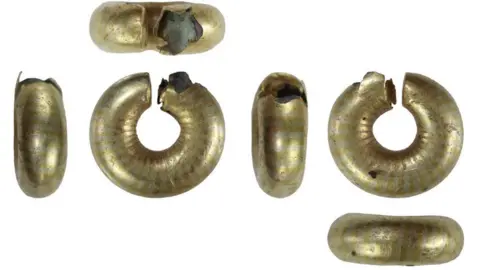Jewellery from Bronze Age a 'notable' find
 Portable Antiquities Scheme
Portable Antiquities SchemeA gold-plated Bronze Age ring thought to have been worn on the ears or nose has been described as a "notable" find.
The ring was found by a metal detectorist in Martham, near Great Yarmouth, Norfolk, in July.
The ring, likely to have been used as a "personal adornment", was declared treasure by a coroner.
Julie Shoemark, of Norfolk County Council, said it was "significant" in that it added to "our understanding of Norfolk's history".
The artefact is classed as a "hair-ring" or "ring-money" but experts believe it was a personal adornment.
'Peculiar object'
"I would say the ring is quite notable," said Ms Shoemark, a finds liaison officer.
"These are a peculiar class of object which are still not fully understood.
"Approximately 170 have been reported as metal detecting finds across England and Wales, nine of which are from Norfolk, with others known from excavation."
The ring, made some time between 1150 and 800 BC, is 19mm (0.74in) high and has a copper alloy core, covered by decorative gold and silver stripes.
Part of its core has corroded over time but Ms Shoemark said that at the time it was made, the item "would have appeared to the viewer as being of solid gold".

What is treasure?
- Under the Treasure Act 1996, finders of potential treasure in England, Wales and Northern Ireland are legally obliged to notify their local coroner
- An inquest then determines whether the finds constitute treasure
- The act contains a number of definitions of "treasure", including prehistoric objects, coins that contain gold or silver and are at least 300 years old, or more recent valuable objects that have been deliberately hidden
- If the find is declared treasure, the finder must offer it for sale to a museum at a price set by the British Museum's Treasure Valuation Committee
- A reward is then offered to the finders and other relevant parties

